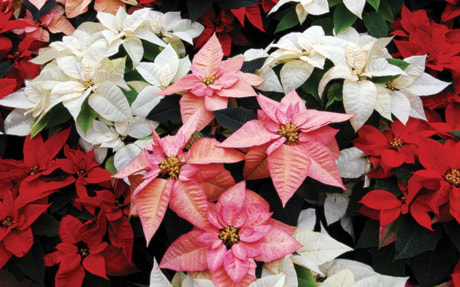Decorating buildings with outside greenery during the winter months is thought to have started in ancient times when the winter solstice was the main celebration.
These traditions evolved into Christmas decorations. In turn, fresh boughs have been replaced with artificial garland, and bright lights.
Fresh plant material is still a popular Christmas decoration but they are seen as potted plants, Christmas trees, wreaths or fresh arrangements inside or out.
A number of specialty potted plants are available at this time of year. They are considered throw away plants as they are economical and are not expected to live past the holiday season.
Poinsettias that bloom profusely in parts of Mexico in December are forced into bloom in colder Northern climates.
Plant breeders have hybridized these plants into what are in the stores today — bright colorful plants in all shades of red, pink and cream.
While the bracts are bright and cheerful, the plants themselves are fussy. Poinsettias drop there leaves at the first sign of stress which includes being too warm, too cool, in a draft or too much or little water.
Other flowering plants such as the amaryllis are much easier to grow.
This bulb grows quickly and has spectacular flowers on top of a long stem. The larger the bulb, the more flower stems it produces. Placing the bulb in a heavy pot will ensure that the top heavy flowers stay upright.
Cyclamen, with their variegated leaves and red, white or pink flowers are also a cheerful addition to any house. These plants do best in a cool, sunny location. An east facing window that is poorly insulated is ideal. The flowers quickly fade in a warmer environment.
Potted compact spruce and juniper are becoming a common sight in stores. Given water and a cool window these plants will survive until spring indoors. They can not be placed outside until the weather warms as they are not conditioned to the cold weather.
Christmas trees have long been a tradition in areas where evergreens are abundant. Now they are part of a multi-million dollar business.
When trees are cut, the plant blocks the bottom of the stem to stop the loss of sap. Making a new cut a few inches up the stem, opens the stemn and allows for the uptake of water, keeping the tree fresh longer.
Natural wreaths are used to adorn the outside of buildings. In cool weather, where the greener does not transpire and loose moisture the wreaths will stay viable for a couple of months. When wreaths are placed in warm areas, they quickly loose moisture and drop needles. Likewise large pots of arranged greenery are attractive additions to the outdoor decorations where they stay cool or frozen.
Natural greenery inside a building must be placed in water or it will quickly dry out and die. During the Christmas season, florists use spruce, pine, fir, holly and ivy in arrangements. When care is taken, the greenery will last a number of weeks. The greenery, like flowers, will stay fresh longer buy re-cutting the stems each week. Like the evergreen tree, fresh cut stems of flowers and branches will close to stop the loss of liquids. Unfortunately, it also limits the intake of water. Re-cutting the stem will increase the stem’s ability to take in moisture.
Live plants make a great addition to the holidays and can last a long time if they are given proper care.
Linda Tomlinson is a horticulturist and educator living in Rocky Mountain House. You can contact her at your_garden@hotmail.com
